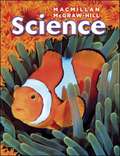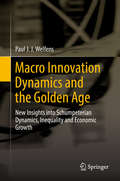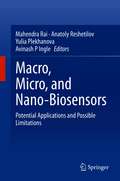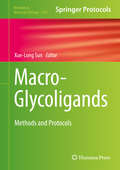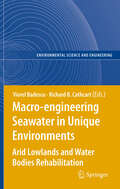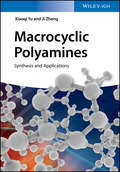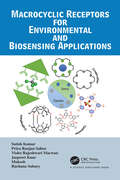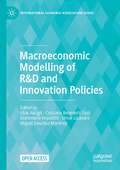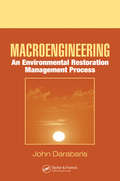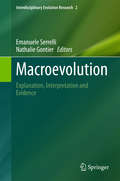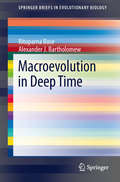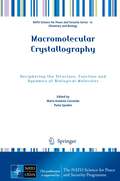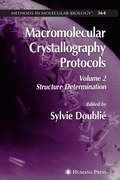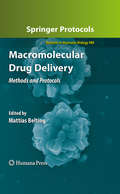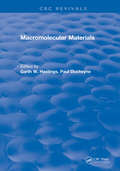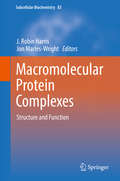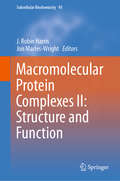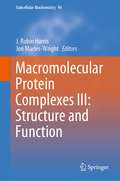- Table View
- List View
Macmillan McGraw-Hill Science (Grade 3, North Carolina Edition)
by Richard H. Moyer Joanne Vasquez Jay Hackett Lucy H. DanielScience is a way of understanding the world around us. Scientists often ask questions about what they observe. They call on many skills to help them answer these questions.
Macmillan McGraw-Hill Science 2nd Grade
by Richard H. Moyer Joanne Vasquez Jay Hackett Lucy H. DanielA level 2 science book with lots of activities and illustrations.
Macmillan McGraw-Hill Science 3rd Grade
by Lucy Daniel Joanne Vasquez Jay Hackett Richard Moyer Pamela Stryker H. Prentice BaptisteThis textbook goes into broad details on life, earth and physical science.
Macmillan McGraw-Hill Science 4th Grade
by Richard H. Moyer Joanne Vasquez Jay Hackett Lucy H. DanielThis study material contains topics on Life Science, Earth Science and Physical Science.
Macmillan McGraw-Hill Science 5th Grade
by Richard H. Moyer Joanne Vasquez Jay Hackett Lucy H. DanielMacmillan McGraw-Hill Science contains unit lessons on Life Science, Living Things, Earth Science, Physical Science, etc.
Macmillan/McGraw-Hill Science (Grade #3)
by Richard H. Moyer Joanne Vasquez Jay Hackett Lucy H. DanielThird grade science textbook.
Macro Innovation Dynamics and the Golden Age
by Paul J. J. WelfensThis book takes a new look at the golden age in neoclassical growth theory and explores in detail sustainability and optimum growth in China, the US and Europe. Innovation, foreign direct investment, trade and growth dynamics are key elements in modern economies - including perspectives on green growth and aspects of the knowledge production function in the context of multinational companies. As such the book considers the role of foreign direct investment in a modified growth model and discusses innovation in an enhanced Mundell-Fleming macro model. Moreover, for the first time it directly links a knowledge production function to the macro production function in a broader context, including real money balances in the production function. It shows - also with empirical relevance - that FDI inward stocks relative to the GDP of host countries, the number of researchers and per capita income are relevant drivers of new knowledge and the stock of knowledge, respectively. This new Schumpeterian theoretical approach lends itself to important policy conclusions for both OECD members and newly industrialized countries.
Macro, Micro, and Nano-Biosensors: Potential Applications and Possible Limitations
by Mahendra Rai Avinash P. Ingle Anatoly Reshetilov Yulia PlekhanovaThis book includes an international group of researchers who present the latest achievements in the field of enzyme, immune system, and microbial and nano-biosensors. It highlights the experimental evidence for formation of biological fuel cells (BFCs)-which has a dual purpose – as a device that produces electricity and the systems which produce it simultaneously cleaning up the environment from polluting organic compounds. Considering the work in the field of macro, micro and nano-biosensors, considerable attention is paid to the use of nanomaterials for the modification of working electrodes. Nanomaterials in some cases can significantly improve the parameters of analytical systems. Readers will be interested in the projection of the presented theoretical and experimental materials in the field of practical application of modern analytical developments. The presented results in many cases imply the possibility of using the created models of macro, micro and nano-biosensors, and biofuel elements in the field of health, and protection/restoration of the environment. It includes information about all existing types of transducers of signals in biosensors – electrochemical, optical and quantum-optics, thermoelectric, data of atomic force microscopy, piezoelectric, and more. On the basis of these principles, descriptions are given about the functioning of macro, micro and nano- biosensors for the detection of compounds used in medicine, detection of compounds that clog the environment, and thus affect human health, for compounds that are potentially the basis for the production of drugs, for the selection of compounds that have medicinal activity, for immunodetection, and to assess the quality of food. These questions form the basis of research carried out in the field of biosensors in the world. Since the described models of biosensors have high sensitivity, high measurement speed and selectivity, the described results attract the attention of both the ordinary reader and business class specialists who create and implement analytical technologies. This book is very useful for researchers in life sciences, chemical sciences, physics, and engineering. In addition, it will be useful for the persons working in industry. Advanced technologies specialists will be attracted by the novelty of the proposed solutions and their relevance and ease of implementation. Since the studies contain sections describing the parameters of different biosensors, BFCs, they are easily navigated into assessing the effectiveness of the practical use of the proposed device. The relevant sections indicate such characteristics as detection ranges, life span, type of biological material used, the method of formation of the bio-receptor part. These parameters are of interest to both developers of new models of biosensors and BFC, and their manufacturers.
Macro-Glycoligands
by Xue-Long SunThis volume details methods and protocols for the synthesis and characterization of glycopolymers and their biomedical applications. Chapters are divided into three parts covering synthesis and characterization of glycopolymers; glycopolymer-nanoparticle conjugates; and surface immobilized glycopolymers. Written for the Methods in Molecular Biology series, chapters include introductions to their respective topics, lists of the necessary materials and reagents, step-by-step, readily reproducible laboratory protocols, and tips on troubleshooting and avoiding known pitfalls. Authoritative and practical, Macro-Glycoligands: Methods and Protocols aims to ensure successful results in the further study of this vital field.
Macro-engineering Seawater in Unique Environments: Arid Lowlands and Water Bodies Rehabilitation
by Viorel Badescu Richard CathcartThe subjects refer to histories of ancient and modern use of seacoasts; possible macro-projects capable of massive changes in the coastlines of the Dead Sea, Red Sea and Persian Gulf caused by canal and massively scaled hydropower dam installations; relevant macro-projects for the Black Sea and Baltic Sea; possibilities of refreshment of the Aral Sea and Iran's Lake Uremia with seawater or river freshwater importation macro-projects; potential rehabilitation of some vital arid zone regions now dominated by moving or movable surface granular materials using unique and unusual macro-projects; seawater flooding of land regions situated below present-day global sea-level; harnessing energy and obtaining freshwater from the world's salt-laden ocean by modern industrial means; various macro-projects designed specifically for the protection (reduction of vulnerability) of particular Earth geographical regions.
Macrocyclic Polyamines: Synthesis and Applications
by Ji Zhang Xiaoqi YuThe first comprehensive book focusing on synthesis and applications of macrocyclic polyamines and their derivatives Macrocyclic polyamines are a class of widely used important compounds. This is the first book that systematically summarizes the synthesis and applications of macrocyclic polyamines and their analogues, including the properties and synthetic methods of macrocyclic polyamines, chemical nucleases based on macrocyclic polyamines, the derivatives of macrocyclic polyamines as nano-vector materials, macrocyclic polyamines derivatives for bio-imaging, chemical sensors based on macrocyclic polyamines, and other applications of macrocyclic polyamines. Macrocyclic Polyamines: Synthesis and Applications includes most of the studies involving macrocyclic polyamines and their derivatives, and may be used as a reference for the researchers in related fields. It offers in-depth coverage of cyclization modes; special procedures for tetraza macrocyclic compounds; diacids-diamines condensation; oxidative DNA cleaving by macrocyclic polyamines; lipids with cationic MPA headgroups; the derivatives of DOTA, DO3A, and PCTA; receptors for anions; sensors for bioactive molecules; macrocyclic polyamines for solvent extraction and membrane transport of amino acids and their derivatives, electrophoretic separation, and open-tubular CEC; and much more. The first book that systematically summarizes the chemistry of macrocyclic polyamines and their derivatives in terms of synthetic methods for their preparation, functionalization, and application in the main fields of chemical sensors, chemical nucleases, drug-delivery, bio-imaging and vector materials Provides a comprehensive reference for the researchers working on macrocyclic polyamines Offers train of thought in related research fields such as organic chemistry, coordination chemistry, analytical chemistry, supramolecular chemistry, biomaterials, etc. Macrocyclic Polyamines: Synthesis and Applications will not only provide a reference for the researchers working on macrocyclic polyamines, but also offer opportunities for researchers in related research fields to understand the benefits of these key compounds.
Macrocyclic Receptors for Environmental and Biosensing Applications
by Satish Kumar Jaspreet Kaur Priya Ranjan Sahoo Violet Rajeshwari Macwan Mukesh Rachana SahneyThe book is designed to highlight the utility of supramolecular systems in diverse areas such as sensing of ionic and molecular analytes, aggregation, artificial molecular machines, biology, and medicine. The synthetic chemistry of a diverse set of supramolecules encompassing various supramolecular interactions involved in driving macrocyclic architectures is discussed. Attempts have been made to cover unique features of macrocycles viz. control over shape, size, and valency along with supramolecular interactions, which direct complex supramolecular systems. The book also provides a discussion on the similarity between macrocyclic host-guest systems and biomolecules, which lay the foundation of building modern artificial molecular motors and switches like protein machines for application in diverse areas. The authors hope that the book will appeal to a wider audience of students and researchers in academics and/or industries.
Macrocyclic and Supramolecular Chemistry: How Izatt-Christensen Award Winners Shaped the Field
by Reed M. IzattThis book commemorates the 25th anniversary of the International Izatt-Christensen Award in Macrocyclic and Supramolecular Chemistry. The award, one of the most prestigious of small awards in chemistry, recognizes excellence in the developing field of macrocyclic and supramolecular chemistry Macrocyclic and Supramolecular Chemistry: How Izatt-Christensen Award Winners Shaped the Field features chapters written by the award recipients who provide unique perspectives on the spectacular growth in these expanding and vibrant fields of chemistry over the past half century, and on the role of these awardees in shaping this growth. During this time there has been an upsurge of interest in the design, synthesis and characterization of increasingly more complex macrocyclic ligands and in the application of this knowledge to understanding molecular recognition processes in host-guest chemistry in ways that were scarcely envisioned decades earlier.
Macroeconomic Modelling of R&D and Innovation Policies (International Economic Association Series)
by Ufuk Akcigit Cristiana Benedetti Fasil Giammario Impullitti Omar Licandro Miguel Sanchez-MartinezThis open access book encompasses a collection of in-depth analyses showcasing the challenges and ways forward for macroeconomic modelling of R&D and innovation policies. Based upon the proceedings of the EC-DG JRC-IEA workshop held in Brussels in 2017, it presents cutting-edge contributions from a number of leading economists in the field. It provides a comprehensive overview of the current academic and policy challenges surrounding R&D as well as of the state-of-the-art modelling techniques.The book brings to the forefront outstanding issues related to the assessment of the macroeconomic impact of R&D policies and its modelling. It speaks to the rising importance of R&D and innovation policy, and the proliferation of macroeconomic models featuring endogenous technological change.The contents of this book will be of interest to both academic and policy audiences working in the fields of R&D and innovation.
Macroengineering: An Environmental Restoration Management Process (Systems Innovation Book Ser.)
by John DarabarisMacroengineering: An Environmental Restoration Management Process provides a comprehensive understanding of all the technical, cost, and regulatory issues that an environmental project manager would potentially face on a large scale environmental restoration project. The author addresses unique technical issues encountered during DOD and DOE environmental cleanup efforts, such as radionuclide contamination, unexploded ordinance, heavy metals, and other common contaminants. Referencing the most recent regulations and practices in environmental cleanup projects, the book also includes useful charts and tables and serves both as a classroom text and a professional reference.
Macroevolution
by Nathalie Gontier Emanuele SerrelliThis book is divided in two parts, the first of which shows how, beyond paleontology and systematics, macroevolutionary theories apply key insights from ecology and biogeography, developmental biology, biophysics, molecular phylogenetics and even the sociocultural sciences to explain evolution in deep time. In the second part, the phenomenon of macroevolution is examined with the help of real life-history case studies on the evolution of eukaryotic sex, the formation of anatomical form and body-plans, extinction and speciation events of marine invertebrates, hominin evolution and species conservation ethics. The book brings together leading experts, who explain pivotal concepts such as Punctuated Equilibria, Stasis, Developmental Constraints, Adaptive Radiations, Habitat Tracking, Turnovers, (Mass) Extinctions, Species Sorting, Major Transitions, Trends and Hierarchies - key premises that allow macroevolutionary epistemic frameworks to transcend microevolutionary theories that focus on genetic variation, selection, migration and fitness. Along the way, the contributing authors review ongoing debates and current scientific challenges; detail new and fascinating scientific tools and techniques that allow us to cross the classic borders between disciplines; demonstrate how their theories make it possible to extend the Modern Synthesis; present guidelines on how the macroevolutionary field could be further developed; and provide a rich view of just how it was that life evolved across time and space. In short, this book is a must-read for active scholars and because the technical aspects are fully explained, it is also accessible for non-specialists. Understanding evolution requires a solid grasp of above-population phenomena. Species are real biological individuals and abiotic factors impact the future course of evolution. Beyond observation, when the explanation of macroevolution is the goal, we need both evidence and theory that enable us to explain and interpret how life evolves at the grand scale.
Macroevolution in Deep Time
by Alexander J. Bartholomew Rituparna BoseThe prerequisite to investigating the underlying causes behind mass extinction is a profound understanding of the evolutionary history of both living and dead species. It is especially important to appreciate the significance of such studies in extinct organisms; especially in organisms that were abundant in a certain geologic era, but have subsequently dwindled or become extinct. Such studies should help to accurately evaluate patterns of evolution in extinct species lineages and help predict the same in its modern analogs. The book includes cutting edge research in evolutionary biology that should serve as a starting point for conservation.
Macromolecular Crystallography
by Maria Armenia Carrondo Paola SpadonThis volume is a collection of the contributions presented at the 42nd Erice Crystallographic Course whose main objective was to train the younger generation on advanced methods and techniques for examining structural and dynamic aspects of biological macromolecules. The papers review the techniques used to study protein assemblies and their dynamics, including X-ray diffraction and scattering, electron cryo-electron microscopy, electro nanospray mass spectrometry, NMR, protein docking and molecular dynamics. A key theme throughout the book is the dependence of modern structural science on multiple experimental and computational techniques, and it is the development of these techniques and their integration that will take us forward in the future.
Macromolecular Crystallography Protocols: Structure Determination
by Sylvie DoublieMacromolecular Crystallography Protocols, now in two volumes, examines major developments that have occurred since publication of the acclaimed first edition nearly a decade ago. Volume 1 is composed of detailed protocols for the preparation and optimization of crystals. Volume 2 complements the first volume by addressing laboratory techniques for crystal handling and structural characterization. The volume concludes with a survey of available crystallographic software.
Macromolecular Crystallography Protocols: Volume 1, Preparation and crystallization of macromolecules
by Sylvie DoublieMacromolecular Crystallography Protocols, now in two volumes, examines major developments that have occurred since publication of the acclaimed first edition nearly a decade ago. Volume 1 is composed of detailed protocols for the preparation and optimization of crystals. Volume 2 complements the first volume by addressing laboratory techniques for crystal handling and structural characterization. The volume concludes with a survey of available crystallographic software.
Macromolecular Drug Delivery
by Mattias BeltingMacromolecular drugs hold the promise of becoming new therapeutics for several major disorders, including cancer and cardiovascular disease. This incredible potential is explored in Macromolecular Drug Delivery, a volume which gives a wide-ranging overview of contemporary methods used in the field, and which addresses the limitations presented by a lack of safe and efficient drug delivery strategies. Chapters offer information on both in vitro and in vivo methods of macromolecular delivery, thus appealing to a broad scientific audience. Composed in the highly successful Methods in Molecular BiologyTM series format, each chapter contains a brief introduction, step-by-step methods, a list of necessary materials, and a Notes section which shares tips on troubleshooting and avoiding known pitfalls. Comprehensive and cutting-edge, Macromolecular Drug Delivery offers a platform for interdisciplinary collaboration, which should provide opportunities for new discoveries at the interface between disciplines. Ultimately, this cooperation will lead to the use of macromolecular drugs as novel diagnostic tools and, even more importantly, as a means to revolutionize the way we view and treat diseases.
Macromolecular Materials
by HastingsThis volume deals with some basic considerations of structure and its relation to function. After outlining some basic principles in the first chapter, including manufacturing effects, structural determination is discussed in detail. This is important since adequate characterization in terms of molecular size is necessary for a proper understanding and suse. The theme of interrelationships between structure and properties is developed in the next chapters. The second part of the volume deals with selected applications in which the development and sue of macromolecultar materials in specific applications is described.The selection of applications includes synthetic and natural polymers and the range of medical areas involved include orthopedics, dialysis, drug release (macromolecular pharmacology) blood contact, and plastic surgery. Since the list could not be completely comprehensive, these represent areas of special development or of continuing problems.
Macromolecular Protein Complexes
by J. Robin Harris Jon Marles-WrightThis volume of the established Subcellular Biochemistry series presents 20 chapters dealing with a broad range of interesting protein complexes. It will enable researchers to readily appreciate the major contribution from both X-ray crystallography and cryo-electron microscopy in this field of study. The biological significance of these structural studies is emphasised throughout the book. The diversity of the material included here indicates the breadth of this field and the tremendous progress that has been made in recent years. The book is directed primarily to advanced students and researchers in structural biology, and others in the biochemical sciences. It will be supplemented by other related books within the Subcellular Biochemistry series. One of the Editors (JM-W) is actively involved in structural biology and the other (JRH), as a retired academic and the Series Editor of Subcellular Biochemistry, has long experience at editing multi-author books.
Macromolecular Protein Complexes II: Structure and Function (Subcellular Biochemistry #93)
by J. Robin Harris Jon Marles-WrightThis book follows on from Volume 83 in the SCBI series (“Macromolecular Protein Complexes”), and addresses several important topics (such as the Proteasome, Anaphase Promoting Complex, Ribosome and Apoptosome) that were not previously included, together with a number of additional exciting topics in this rapidly expanding field of study. Although the first SCBI Protein Complex book focused on soluble protein complexes, the second (Vol. 87)addressed Membrane Complexes, and the third (Vol. 88) put the spotlight on Viral Protein and Nucleoprotein Complexes, a number of membrane, virus and even fibrillar protein complexes have been be considered for inclusion in the present book. A further book is also under preparation that follows the same pattern, in an attempt to provide a thorough coverage of the subject.Chapter 9 is available open access under a Creative Commons Attribution 4.0 International License via link.springer.com.
Macromolecular Protein Complexes III: Structure and Function (Subcellular Biochemistry #96)
by J. Robin Harris Jon Marles-WrightThis book covers important topics such as the dynamic structure and function of the 26S proteasome, the DNA replication machine: structure and dynamic function and the structural organization and protein–protein interactions in the human adenovirus capsid, to mention but a few.The 18 chapters included here, written by experts in their specific field, are at the forefront of scientific knowledge. The impressive integration of structural data from X-ray crystallography with that from cryo-electron microscopy is apparent throughout the book. In addition, functional aspects are also given a high priority. Chapter 1 is available open access under a Creative Commons Attribution 4.0 International License via link.springer.com.


